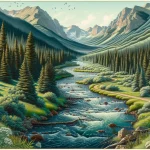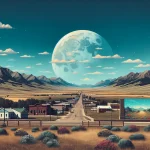Nestled in the heart of Mesa Verde National Park, the Pueblo Cliff Dwellings stand as a testament to the ingenuity and resilience of the ancestral Puebloan people who once thrived in the rugged landscape of southwestern Colorado. These remarkable structures, built between 1150 and 1300 CE, are some of North America’s best-preserved examples of ancient cliff dwellings.
In This Article
TL;DR
- The Pueblo Cliff Dwellings are an architectural marvel, showcasing the skill and adaptability of the ancestral Puebloans who built them using local stone and adobe mortar.
- These dwellings provide invaluable insights into the daily life, cultural practices, and survival strategies of the Puebloan people who inhabited the Mesa Verde region over 700 years ago.
- Conservation efforts by the National Park Service and other organizations are crucial for preserving this important heritage site for future generations to learn from and appreciate.
The Architectural Ingenuity of the Ancestral Puebloans
The Pueblo Cliff Dwellings were constructed using a combination of hand-hewn stone blocks and adobe mortar, with wooden beams and branches used for roofing. The Pueblo Indian cliff dwellers strategically built their homes in the shelter of cliff alcoves, which provided natural protection from the elements and potential invaders. Some key features of the cliff dwellings include:
- Multi-story structures with terraced designs, allowing for efficient use of space
- Kivas (circular ceremonial rooms) integrated into the living areas
- Sophisticated masonry techniques that have withstood the test of time
While cliff dwellings are not unique to the Mesa Verde region, the scale and complexity of the Pueblo Cliff Dwellings set them apart from similar structures found elsewhere in the world.
The largest and most well-known cliff dwelling is Mesa Verde Cliff Palace, which has over 150 rooms, 20 kivas, wooden beams, and mortar. The National Park Service offers a guided tour of the Cliff Palace, with tickets available at the Mesa Verde Visitor Center outside the park.
Daily Life and Survival Strategies
The ancestral Puebloan farmers were skilled at cultivating crops such as corn, beans, and squash on the mesas above their cliff dwellings. To cope with the arid climate of the Colorado Plateau, they developed innovative water management techniques, such as checking dams and reservoirs.
Within the cliff dwellings, extended families or clans lived together in courtyard complexes centered around kivas. These tight-knit communities worked together to ensure survival and maintain cultural traditions.
Spiritual Beliefs and Cultural Practices
Kivas played a central role in the spiritual and social life of the Puebloan people. These circular, subterranean chambers served as gathering places for religious ceremonies, community meetings, and other important events.
Artifacts and petroglyphs found within the cliff dwellings provide glimpses into the rich spiritual world of the ancestral Pueblo people, who drew inspiration from the natural world around them. Astronomical alignments and the use of natural landmarks in their architecture suggest a deep connection between their cultural practices and the rhythms of the cosmos.
Historical Timeline and Key Events
The ancestral Pueblo Indian tribes began constructing the cliff dwellings at Mesa Verde around 1150 CE, during a period known as the Pueblo III era. Over the next 150 years, the population of the region grew, and the cliff dwellings expanded to accommodate the increasing number of residents.
However, by the late 1200s, a combination of factors, including prolonged droughts, resource depletion, and possible social unrest, led to the gradual abandonment of the cliff dwellings. By 1300 CE, the ancestral Pueblo people had migrated to other parts of the Southwest, leaving behind the magnificent structures that continue to inspire and intrigue us today.
FAQ
What are the Pueblo Cliff Dwellings of Colorado?
The Pueblo Cliff Dwellings are ancient stone and adobe structures built by the ancestral Puebloan people between 1150 and 1300 CE in the alcoves of cliffs in Mesa Verde National Park, Colorado.
How were the Pueblo Cliff Dwellings constructed?
The cliff dwellings were built using hand-hewn stone blocks, adobe mortar, and wooden beams for roofing. The Puebloans utilized the natural protection of cliff alcoves and employed sophisticated masonry techniques to create multi-story, terraced structures.
What can we learn about the daily life of the ancestral Puebloans from these dwellings?
The cliff dwellings provide insights into the Puebloans’ agricultural practices, water management techniques, social structure, and community life. The presence of kivas and courtyard complexes suggests a tight-knit, communal lifestyle centered around shared spiritual beliefs and cultural traditions.
Why did the ancestral Puebloans leave the cliff dwellings?
A combination of factors, including prolonged droughts, resource depletion, and possible social unrest, likely contributed to the gradual abandonment of the cliff dwellings by the late 1200s. The ancestral Puebloans migrated to other parts of the Southwest, adapting to new environments and challenges.
How are the Pueblo Cliff Dwellings being preserved for future generations?
The National Park Service, in collaboration with other organizations, is actively working to conserve and protect the Pueblo Cliff Dwellings for future generations. These efforts include ongoing archaeological research, stabilization of the structures, and educational programs to raise awareness about Puebloan cliff dwellers and the significance of this ancient heritage site.
Are guided tours of the cliff dwellings in Mesa Verde available?
Yes! A guided tour is available for Cliff Palace, the largest and most famous of the cliff dwellings. Tickets can be purchased at the Mesa Verde Visitor Center before entering the park.






